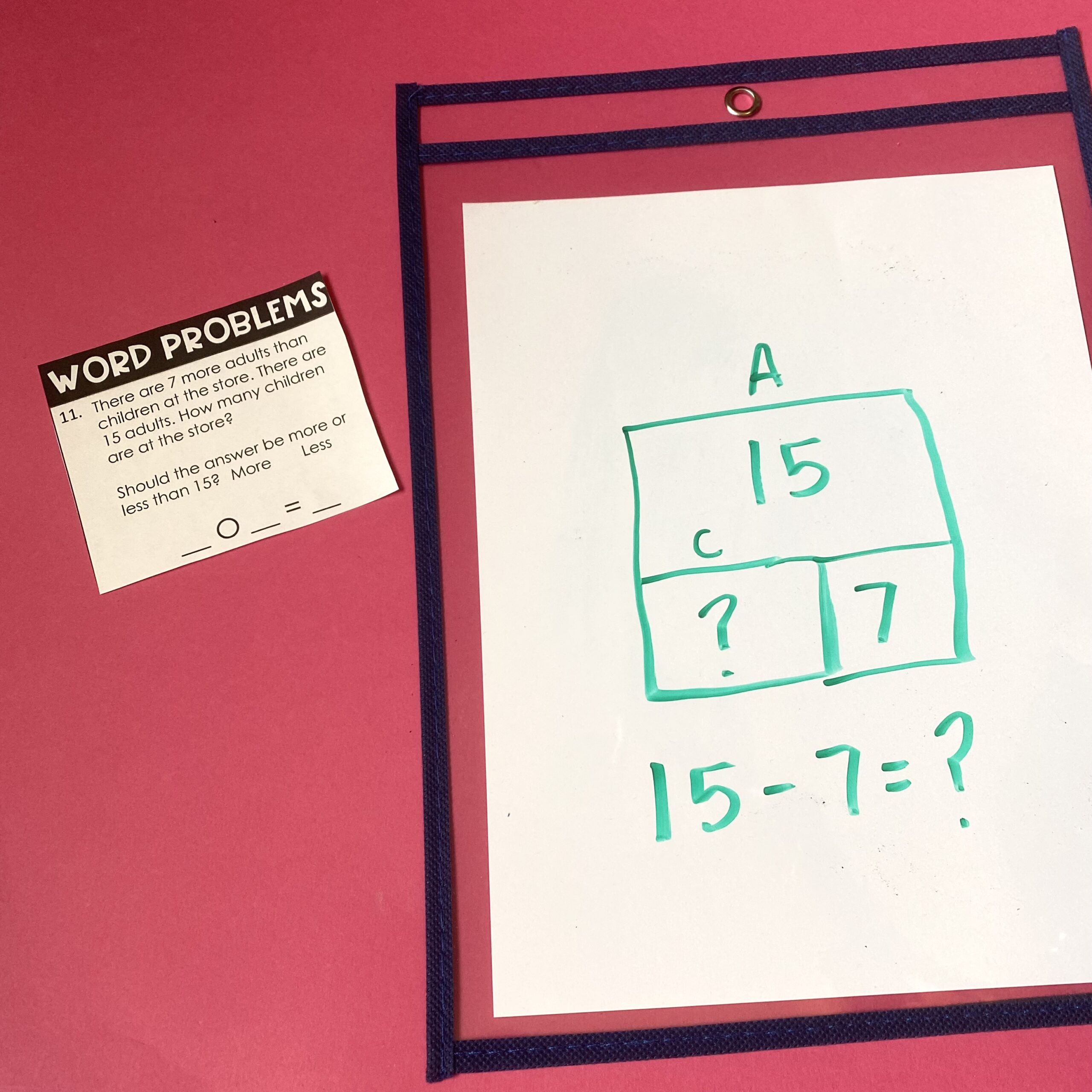Let’s face it. Math word problems can be tricky for students and adults trying to teach them. I have always considered myself a math person, but some of the math word problems in our 2nd grade curriculum confused me. But then I figured out that there are different types of addition and subtraction word problems, and once I figured that out they never confused me again. Because of this, I discovered I could teach my students math word problems solving strategies to help them.
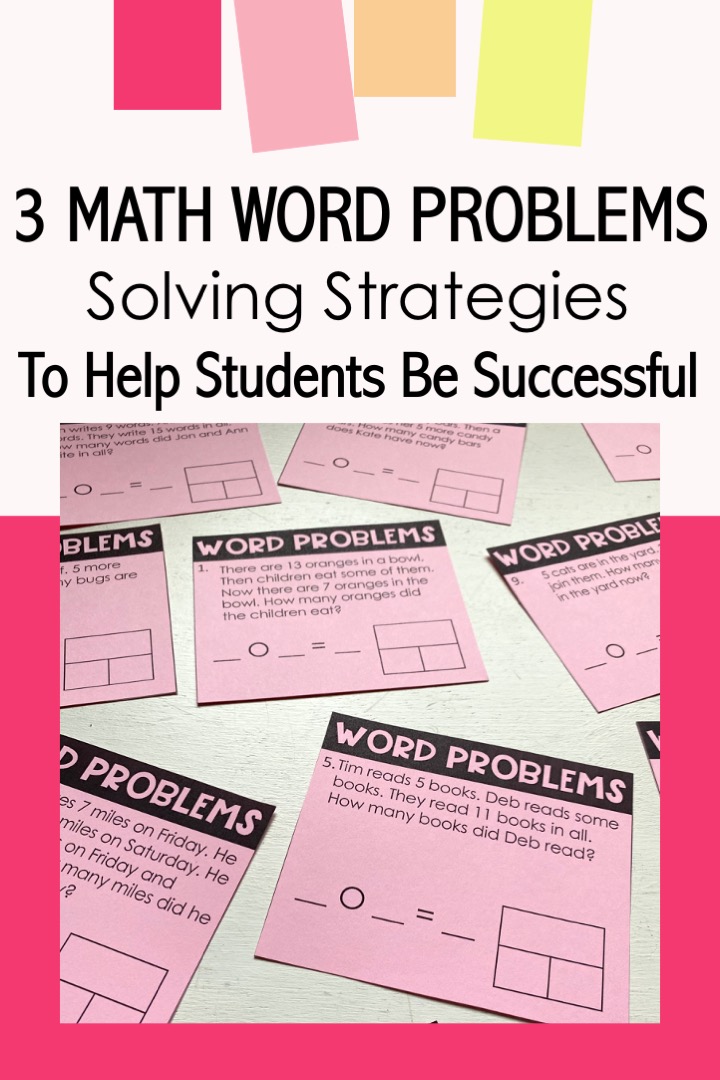
Learn the math word problems solving strategies that has made such a big difference in my 2nd grade classroom.
So today I thought I would share math word problem strategies that work with addition and subtraction based problems for 1st grade, 2nd grade, and 3rd grade.
But first… If you’re a parent who has a child struggling with math, you’ve got to check out Learner. Learner is an online tutoring platform that sets students up for success. To get started take a short quiz about your child’s needs. Then Learner’s Success Management Team reviews that and matches your child with the perfect tutor. Get your $25 trial here.
Math Word Problems Solving Strategies
I think the trickiest part of math word problems is knowing what operation needs to be used. Should I add or subtract? These 3 math word problems solving strategies will help students know what to do for every addition and subtraction word problem.
Math Word Problem Strategies: Part-Part-Whole
One math word problem strategy that helps students know whether to add or subtract is using a part-part-whole diagram.
A part-part-whole diagram is a rectangle that is split in half longwise and then the bottom portion is split in half. So there are three sections. A big one on top and two on bottom.
As you read through the word problem, fill in the numbers in the diagram. Two numbers will fit in there and the blank one you need to either add or subtract to figure it out.
Let me show you this with an example.
“There are 13 oranges in a bowl. Then children eat some of them. Now there are 7 oranges in the bowl. How many oranges did the children eat?”
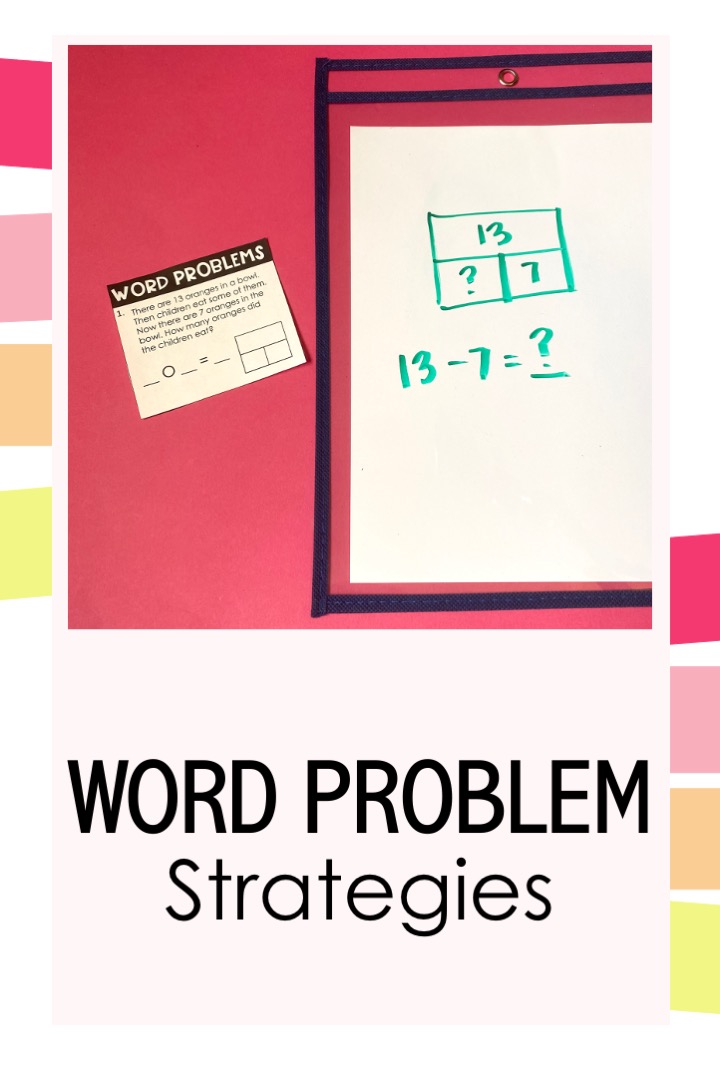
To help my students with math word problems strategies, I like to teach them how to draw a part-part-whole diagram.
With this one you would draw your part-part-whole diagram and read back through, filling in the known numbers. There are 13 oranges in a bowl. That’s how many there are all together so that is the whole. You would put 13 in the top part of the diagram. Keep reading through the word problem. Then children eat some of them. Do we know how many? No, so you put a question mark in one of the parts squares. Continue reading to find the next part. Now there are 7 oranges in the bowl. 7 goes in your next part. How many oranges did the children eat? That’s the part we are trying to figure out.
Keep reading this blog post because I will talk more about how knowing patterns will tell whether you should add or subtract. I like to help my students see that if we have the whole and a part, but not the other part they need to subtract to find the answer. So the equation for this word problem would be 13-7.
To find the answer, I like to model using a math fact strategy. Or I could have students help me find the answer by using a math fact strategy. To learn more about math fact strategies and how to teach them you your students, read this blog post here: Math Fact Strategies That Work
Wanting part-part-whole based problems to work through with your students? Check out this resource here.
Math Word Problem Strategies: Comparison Word Problems
It’s important for students to recognize if a problem is a part-part-whole based problem or a comparison based word problem. Comparison based ones can be tricky for students if you teach them to use keywords. I avoid saying things like “If the problem says more, you add. If the problem says fewer, you subtract.” That is not always the case and students will struggle.
What we want to encourage students to do is find who has more or who has less in the word problem. From that they can make a part-part-whole so they can always know whether they should add or subtract.
Let me give you an example:
“There are 7 more adults than children at the store. There are 15 adults. How many children are at the store?”
Now if you were just doing this problem based on keywords, you think you would add because it says “more.” But if you do that, you would get the answer wrong. And that is why these math word problems solving strategies are so important.
Instead, we are going to think who or what has more. Are there more adults or children? The problem says there are 7 more adults than children at the store. So we know there are more adults.
I like to tell my students to draw a long line and label an “A” above it to stand for adults. Since we know there are more adults, then there must be less children. So I tell students to draw a shorter line under the one they just drew and label it “C” for children. Then I show my students that we can turn those lines into a part-part-whole.
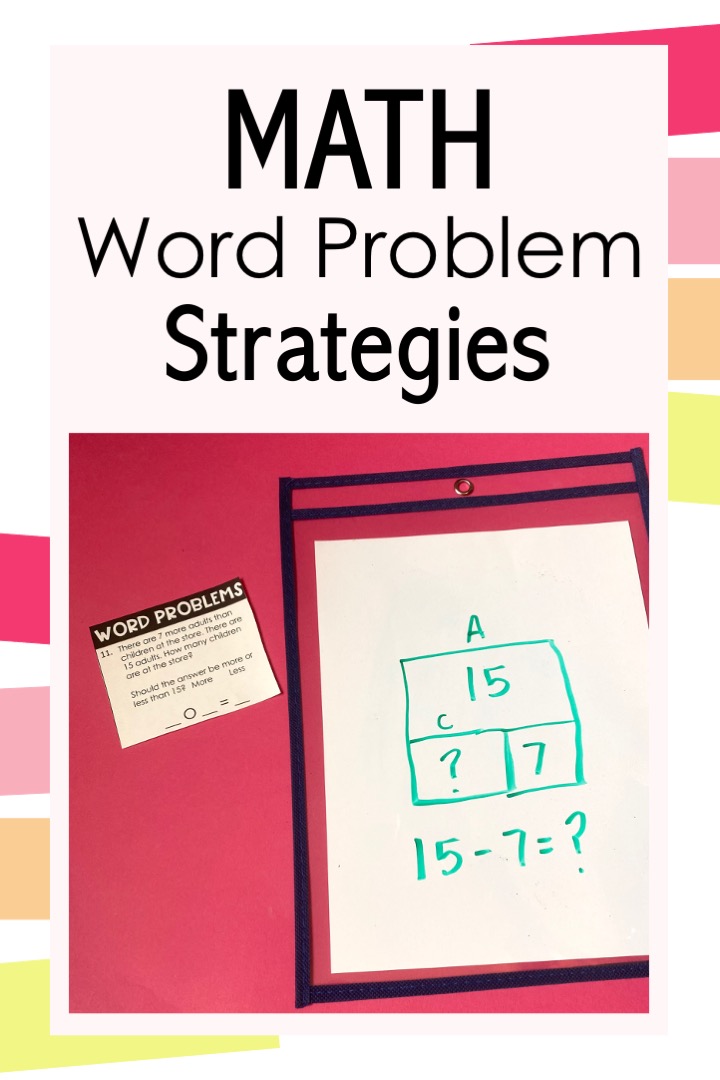
The best tip I have on how to teach math word problems is to help your students recognize comparison word problems.
Now we can read back through the problem and fill in the known numbers in my part-part-whole.
“There are 7 more adults than children at the store.” Is that the number of adults? No. Is that the number of children? No. So that number goes in the other part that is not labeled. “There are 15 adults.” Is that our number for adults? Yes. So we put that number in the whole because that’s the one labeled for adults. “How many children are at the store?” That’s what we are trying to figure out. So we look at our part-part-whole to see if we add or subtract. We have the whole and a part, but not the other part, so we subtraction. 15-7=8, so there are 8 children at the store.
Wanting more comparison based word problems to practice with your students? Check out this resource here.
Math Word Problem Strategies: Use Patterns
With all the math word problem solving strategies, having students see patterns in math is very important. We want students to see that if they have the whole and a part, but not the other part, they subtract. Or if they have the two parts, but not the whole, they need to add. But how do we help students see and actually use those patterns?
For me and my students, I have seen working with fact families really helpful. I like to help my students learn fact families with what I call fact family triangles. I even have one up on our math wall so when we do our daily whole class math review we can practice a fact family.
Fact families triangles have a number up at the top and a number on each bottom corner. These numbers are related meaning the two bottom corner numbers equal the top number. This is like the part-part-whole diagram. The two parts equal the whole. These numbers are related.
At the beginning of the school year, I give my students the 3 numbers to the fact family triangles. Then they have to tell me the 2 addition equations and the 2 subtraction equations that make up that fact family. I record those equations in the middle of the fact family triangle.
When they get the hang of that, I put only two numbers in the fact family triangle and a question mark to represent the third or unknown number. Students have to tell me the 4 equations with the “?” in them. Once we do that, we look at the equations that have the equation mark last. We can use that equation to figure out the unknown number.
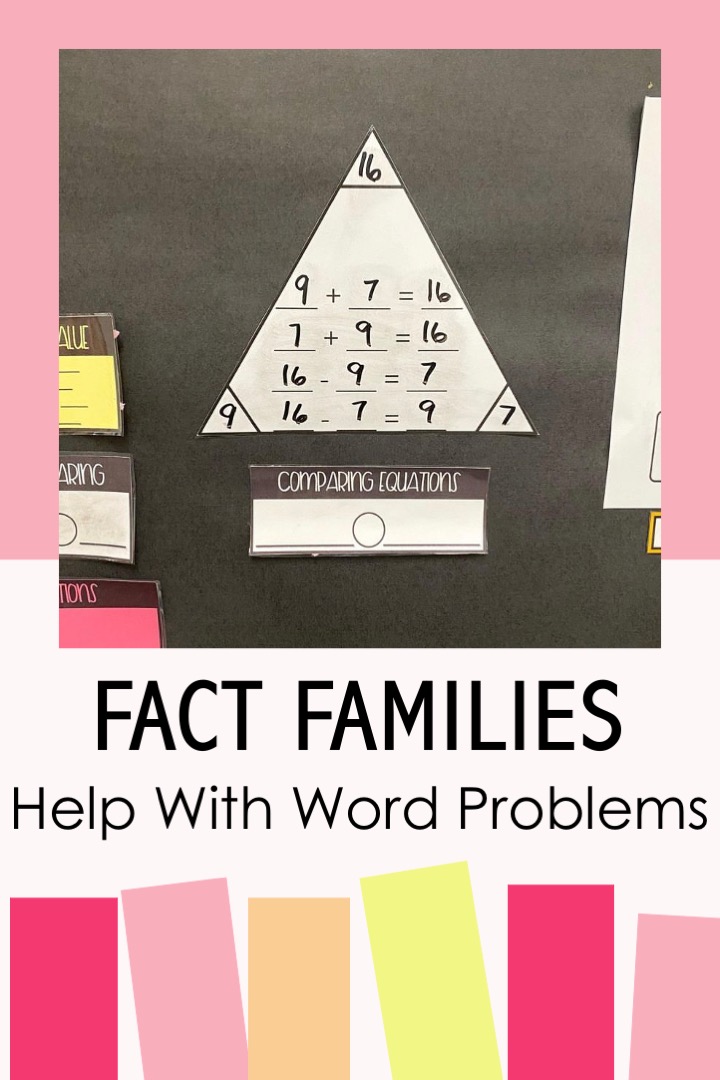
Practicing fact families daily really helps my 2nd graders solve word problems easier.
After practicing this a few times, I show many students how this is really just a part-part-whole diagram and we start talking about the patterns. If we have the whole and a part, but not the other part, we need to subtract to find the unknown number. If we have the two parts but not the whole, we need to add to find the unknown number.
Students catch on to these patterns fairly quickly. It helps a bunch as they are solving word problems.
To learn more about teaching Fact Families in your classroom, read this blog post here: 3 Reasons Why You Need to Teach Fact Families
Check out my fact family resources to use with your students here.
How to Teach Math Word Problem Strategies
Model
When I first teach math word problem strategies, I model to students. I “think out loud” to my students. I solve the problem with no input from students, but I am explaining all of my thinking.
I’m drawing out a part-part-whole or my comparison lines. I am talking about what kind of word problem it is and why I think it is that kind. I’ll even put in the numbers in my part-part-whole and explain why I think they go where I think they go. And of course, I will share the patterns of, “If I have the whole and a part, but not the other part, I subtract.” Or, “if I have the two parts, but not the whole, I add.”
Students catch on to this and will start to use that reasoning as they help you solve and solve word problems on their own. It really is the best way on how to teach math word problem strategies to young students.
Guided Practice
After modeling, I like to have students help me solve the word problems. I’ll display some word problems up on the board and have students help me read the problem, and then determine if it is a part-part-whole problem or a comparison problem. Students will draw the diagram to match the problem. I will get them involved in helping me know where the numbers go in the diagram and explain how they know why it goes there.
Next, I will have students do a little more by themselves. We will still read the problem together and determine what kind of word problem it is, but then they fill in the diagram by themselves. Then we will check their work and talk about why they decided they needed to add or subtract.
Then I will have students work with partners and complete a scoot activity. This is an activity where I put word problems around my classroom and give students a recording page. They go around the room with their partner and solve the problems. I set out a key for them to check their work when they are done. I love how this gets students out of their seats and moving. But what I love more is that it gets them talking to their partners about the math.
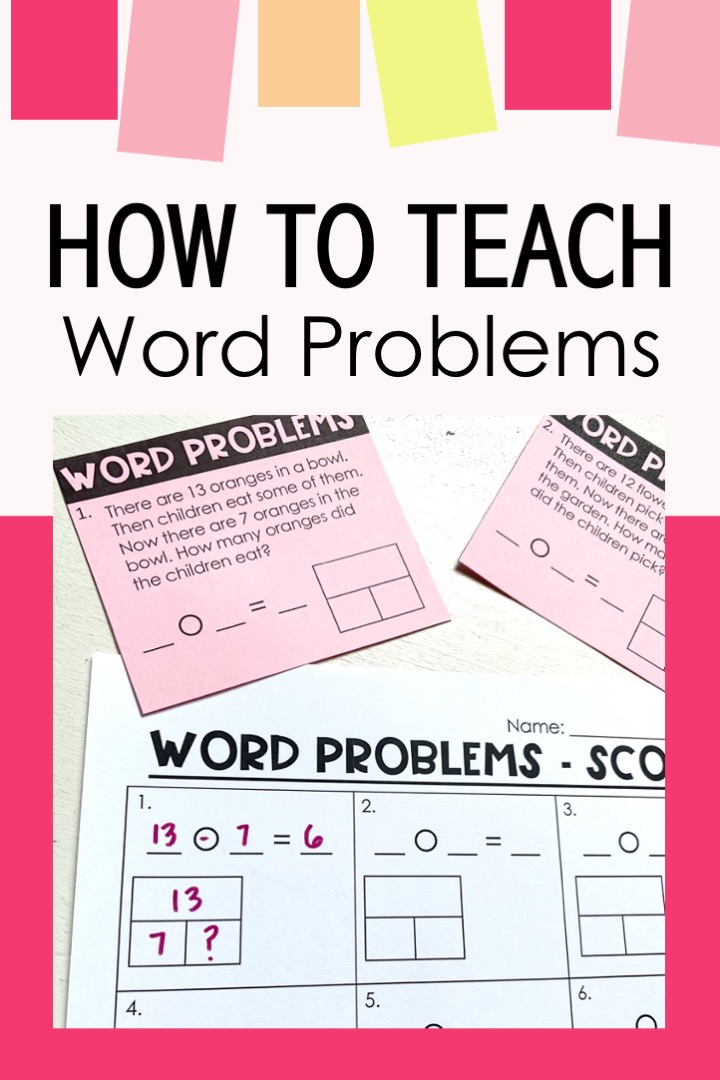
This scoot activity is a great way for students to practice math word problems solving strategies.
I love to hear them say “This is a comparison problem because…” or “We need to put 14 in the whole because…” Or “We need to add to get the answer because…” It makes my teacher heart so happy when I see them using math word problems solving strategies.
Find the scoot activities I have my students do here.
Independent Practice
Then I want to know what students can do by themselves. I have them complete a worksheet with a few word problems. When they are finished they come to me and I will check their work with them. I can help when they make a mistake and I can gauge who understands or who needs more support. Find the worksheets I use for this here.
I hope that after reading this, you have seen that word problems don’t need to be scary for us or students. It all comes down to math word problem solving strategies. First, determine what type of word problem it is and then use patterns to know if you should add or subtract.
Did you know that students are more successful with word problems when they are fluent with their addition and subtraction facts? Learn more about how to get your 1st and 2nd grade students to math fact fluency with this free workbook for teachers: The 7 Steps to Ensure Math Fact Fluency

Download your free copy here.

